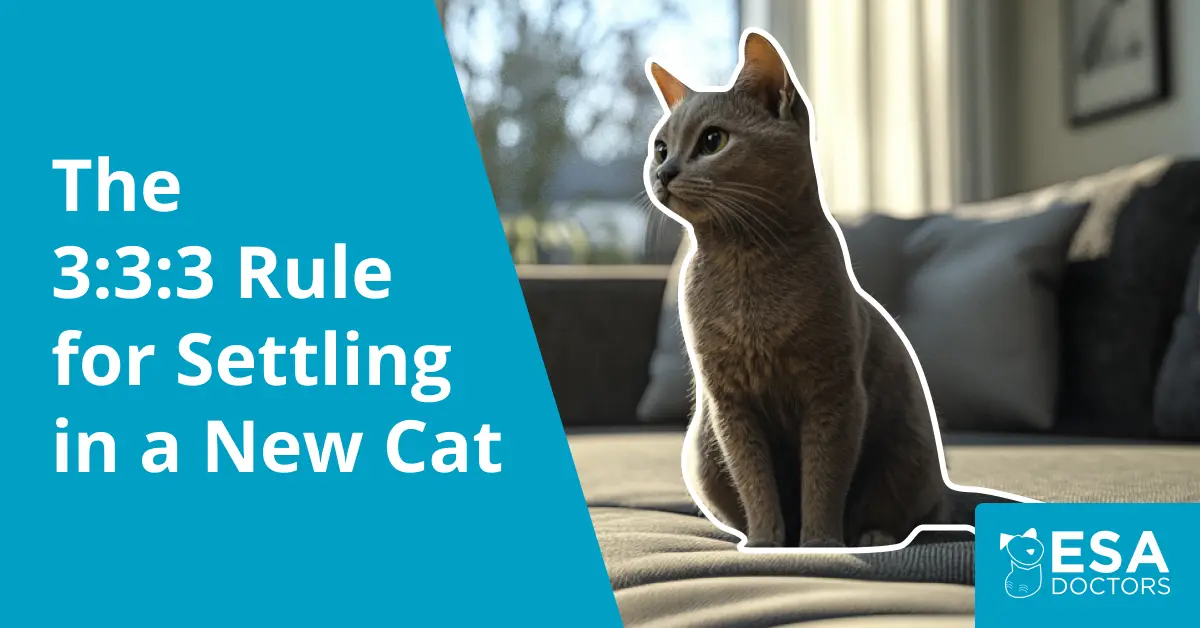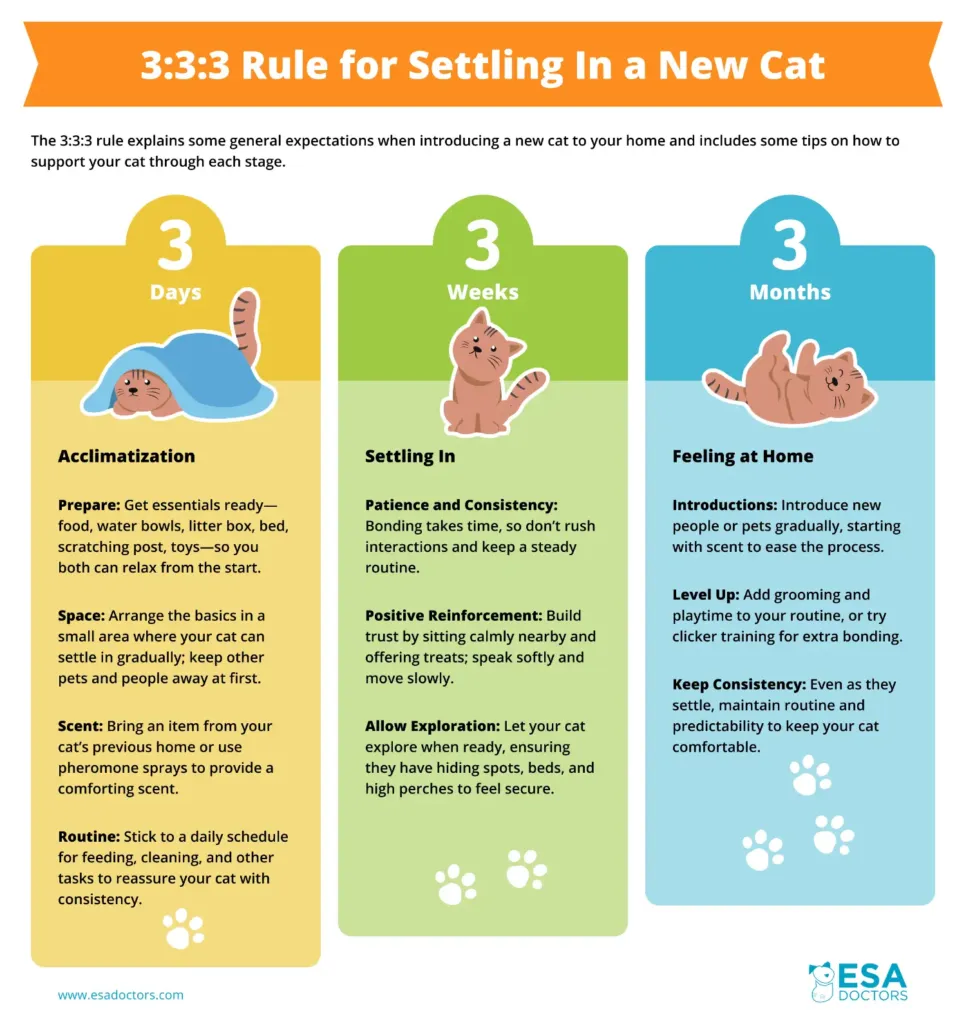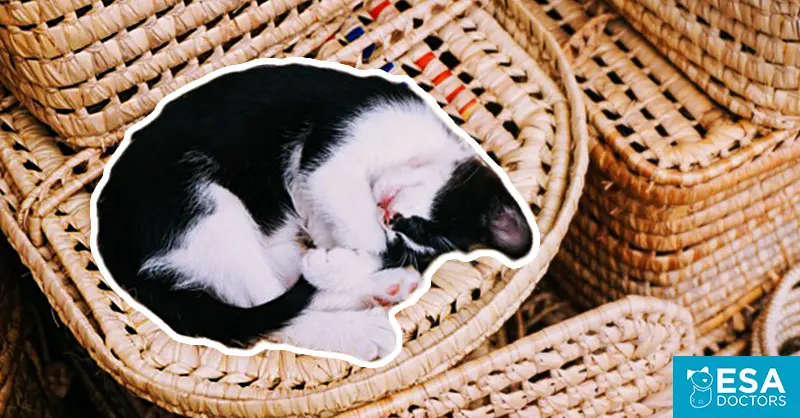Bringing a new cat into your home is a time of great excitement and joy, but it’s important to make the transition as smooth as possible. Relocating can be a stressful time for pets, but there are lots of things we can do to help. The 3:3:3 rule explains some general expectations for the transition process and some tips on how to support your cat through each stage: 3 days for initial acclimatization, 3 weeks for settling in, and by 3 months, they should be comfortable and at ease in their home.
Understanding Cat Behavior During Transitions
Cats are territorial, so moving into a new environment can be a difficult process for them. They will need some considerable time to familiarize themselves with their new home. Cats are also creatures of habit and may feel anxious if their previous routine is disrupted. These pressures can cause cats to behave differently than we might expect — they may hide away a lot, have a poor appetite, toilet in odd places, and even become aggressive when approached. It’s important to understand that these behaviors are likely the results of anxiety, and, therefore will subside with time and positive interactions.
Understanding the root of these behavioral quirks can help new owners help their cats settle in. Providing a consistent routine and giving new cats some space and time to adjust is essential. There are other factors that may help as well, such as providing comforting scents, hiding spaces, and plentiful resources.
The First 3 Days: Acclimatization
In the rule of 3:3:3, the first 3 refers to the initial period of acclimatization, which lasts for approximately 3 days. This is the hardest period for both the cat and the new owner, and most cats require a lot of patience and space.
Tips for the First 3: 3 Days
Remember, your new cat is going to be feeling pretty stressed at this time. Here’s how to help:
- Prepare: Have everything your cat might need ready before they arrive. The basics include food and water bowls, litter and a litter box, a safe hiding space, a cat bed or blanket, a scratching post, and toys. Being well-prepared with the essentials means you can relax when they arrive, allowing your cat to relax, too!
- Space: Set up all the above essentials in a small room or area where your cat can acclimatize to your home. Give them plenty of time and space — many cats will spend a good deal of these first few days in hiding. Keep other pets and people away first to prevent being overwhelmed.
- Scent: if possible, bring something from your cat’s previous home with them so they have something that smells comforting. Another option is pheromone sprays or diffusers, which can help calm and comfort your cat.
- Routine: be consistent and patient. Try to empty litter trays, fill food and water bowls, and do other daily tasks at around the same time each day so that your cat is reassured by the predictability.
The Second 3 Weeks: Settling In
The second 3 is measured in weeks — it takes most cats roughly 3 weeks to settle into their new environment and begin to feel more comfortable. In these three weeks, your cat will begin to hide less, explore, and learn the routines and quirks of their new household.
Tips for the Second 3: 3 Weeks
In all the excitement of bringing a new cat home, it’s easy to get over-enthusiastic in this initial period. Remember, patience is key. Here’s how to progress over the settling in a 3-week period.
- Patience and consistency: Three weeks may seem like a lifetime when you’re desperate to bond with your new cat, but it’s still very early days. Don’t force interactions and keep your routine consistent.
- Positive reinforcement: When your cat starts to emerge from their hiding and gain a little confidence, you can begin to form a bond with them. Start by sitting quietly in their room and putting some treats away from you, near your cat. If they come out to eat them, offer a few more. Talk in a calm, quiet voice and make slow movements.
- Allow exploration: When your cat becomes less anxious, they may wish to start exploring beyond their initial safe space. Make sure they have enough resources such as litter trays and water bowls, and a variety of beds and safe hiding spaces. Cats often like to go up high, so providing some high perches will be appreciated.
The Third 3 Months: Feeling at Home
The last part of the 3:3:3 rule is a very satisfying one, as it signals that after around 3 months, most cats are feeling at ease and comfortable in their new home and routines. You will likely know their character by now, and they will be showing you plenty of relaxed, natural behaviors such as stretching, scratching, and playing. Hopefully, you’ll be well on your way to forming that special cat-owner bond that is so precious.
Tips for the Third 3: 3 Months
Your cat should now consider your home to be their home — and may well be asserting their superiority over all other inhabitants! There may be some boundary-testing, so here are some tips for a harmonious home.
- Introductions: Now that your cat is happy and confident in their home, you can start introducing new people and other pets. Always take things slow, and introduce scent first where possible.
- Level up: With your basic routine now settled, consider adding any extras, such as grooming sessions and playtime. Why not try clicker training for something new?
- Keep the consistency: It can be easy to get complacent now that your cat is more settled, but remember that cats thrive on predictability and routine, so try to maintain consistency.
Factors That Influence Cat Adjustment
While the 3:3:3 rule provides an excellent framework for understanding how cats adjust to new homes, various factors can significantly impact this timeline. Understanding these influences can help you adapt your approach to better suit your cat’s specific needs and circumstances.
The Impact of Age on Adjustment
Age plays a crucial role in how quickly and smoothly a cat adapts to their new environment. Kittens, with their naturally adaptable minds and fewer established habits, often adjust more quickly than their adult counterparts. Their heightened neuroplasticity means they’re more receptive to new experiences and environments, potentially shortening the adjustment period to what might be called a 2:2:2 rule. However, this faster adaptation comes with its challenges — kittens require more frequent feeding, constant supervision, and additional energy outlets.
Adult cats, aged six months to seven years, typically follow the standard 3:3:3 timeline, though their previous experiences heavily influence their adjustment period. These cats have established personalities and preferences that need to be respected during the transition. Senior cats, on the other hand, often need an extended adjustment period, possibly following a 4:4:4 rule. Their sensitivity to environmental changes means they require extra patience and consideration, with special attention paid to their comfort and accessibility needs.
The Journey: From Previous Home to Yours
A cat’s background — whether they come from a shelter, breeder, or the streets — significantly impacts their adjustment process. Shelter cats often carry emotional baggage that requires additional patience and understanding. These cats might need a more structured approach to the 3:3:3 rule, with particular emphasis on creating safe spaces and building trust gradually. Maintaining some aspects of their shelter routine can provide comfort during the transition.
Cats from breeders typically present a different scenario. Usually well-socialized from birth, these cats often adapt more readily to new environments, particularly if you can maintain some of their established routines. The breeder can be a valuable resource, providing insights into the cat’s preferences and habits that can ease the transition.
Feral or street cats represent perhaps the most challenging adjustment scenario. These cats might need what could be called a 6:6:6 rule or even longer, requiring extraordinary patience and specialized approaches to socialization. Their journey to becoming comfortable in a domestic setting is unique and deserves special consideration in terms of space, interaction, and trust-building activities.
Environmental Considerations and Seasonal Effects
The time of year you bring your cat home can influence their adjustment period in surprising ways. Spring and summer months offer natural enrichment through open windows and increased activity but may also present challenges regarding temperature regulation and outdoor distractions. Fall and winter months might require more creative indoor enrichment strategies and additional comfort measures to help your cat feel secure.
Special Circumstances: Children and Multi-Pet Households
Homes with children require careful consideration when implementing the 3:3:3 rule. Young children’s natural enthusiasm can overwhelm a new cat, potentially extending the adjustment period. Creating a structured introduction process that includes teaching children appropriate interaction techniques and establishing child-free zones for the cat can help maintain the standard timeline.
In households with existing pets, the adjustment period often needs modification to account for proper animal introductions. The process of integrating a new cat with resident pets, or emotional support animals, requires its own timeline, running parallel to the general adjustment period. This might include extended periods of separation, supervised introductions, and careful management of shared resources.
When the 3:3:3 Rule Needs Adjustment
Sometimes, despite our best efforts, cats may struggle to adjust within the standard timeline. Understanding why this happens and how to respond can make the difference between successful adoption and ongoing challenges.
For cats showing excessive hiding behavior beyond the three-week mark, it’s essential to recognize this as a sign of deep-seated anxiety rather than simple shyness. Moving resources closer to their preferred hiding spots, using high-value treats, and creating an extremely predictable daily schedule can help these cats build confidence gradually. In some cases, consulting with a veterinarian about anxiety aids might be appropriate.
Poor appetite during the adjustment period requires special attention, as it can quickly become a health concern. Offering a variety of foods, warming meals slightly to enhance aroma, and ensuring feeding locations feel safe and secure can help encourage eating. Some cats may benefit from hand-feeding or appetite stimulants under veterinary supervision.
Putting it all together
The 3:3:3 rule is a valuable framework for understanding how cats adjust to a new home, while recognizing that each cat’s journey is unique. Cats can need 3 days for initial acclimatization, 3 weeks to settle into routines, and 3 months to feel fully at home. However, factors such as age, background (shelter, breeder, or feral), season, and household composition can significantly impact this timeline. Some cats may adapt more quickly, following a 2:2:2 pattern, while others — particularly senior or feral cats — might need extended periods like 4:4:4 or even 6:6:6. Understanding these variables helps create a smoother transition for both cat and owner.
Does your cat provide emotional support?
Work with a licensed professional to get a legit ESA letter in your state.






Leave a Comment